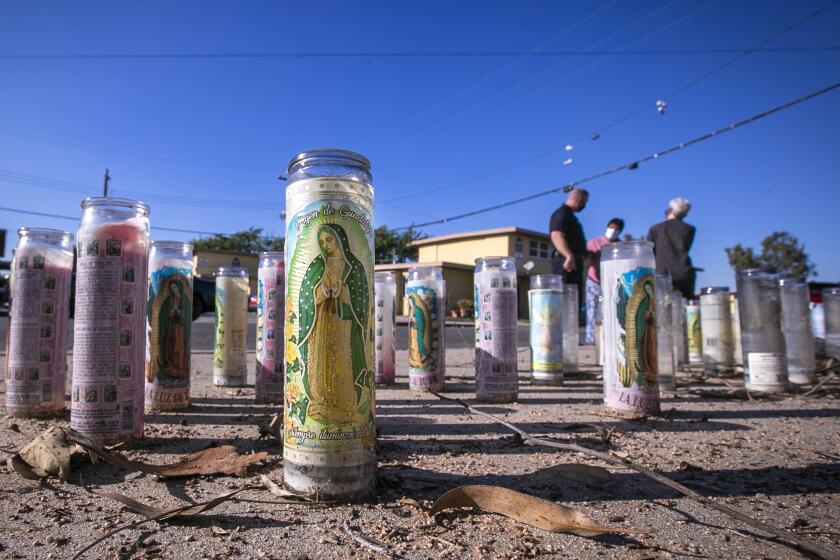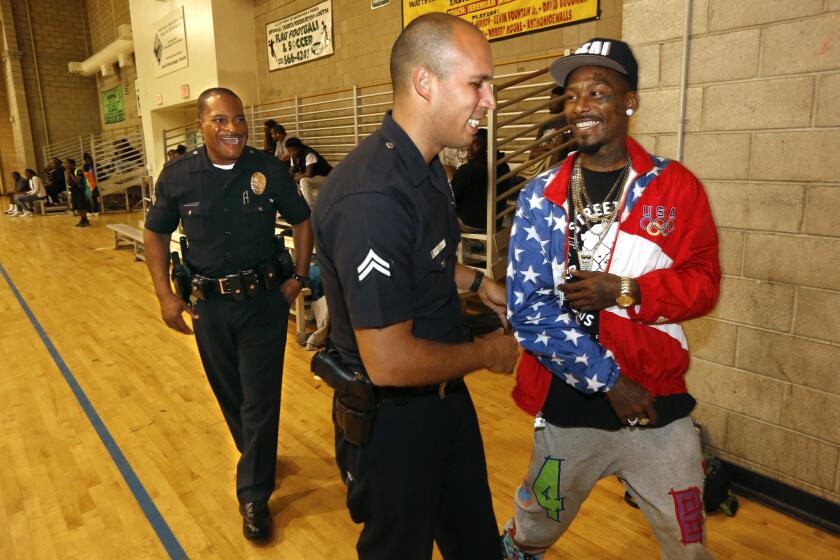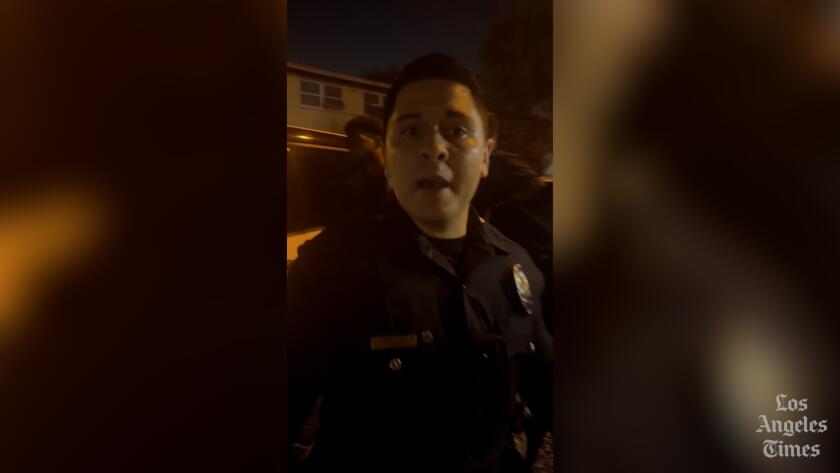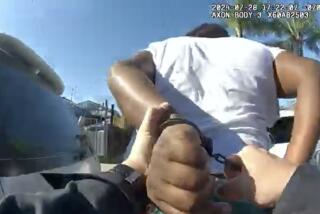Viral arrest sparks outrage and questions about community policing at Nickerson Gardens
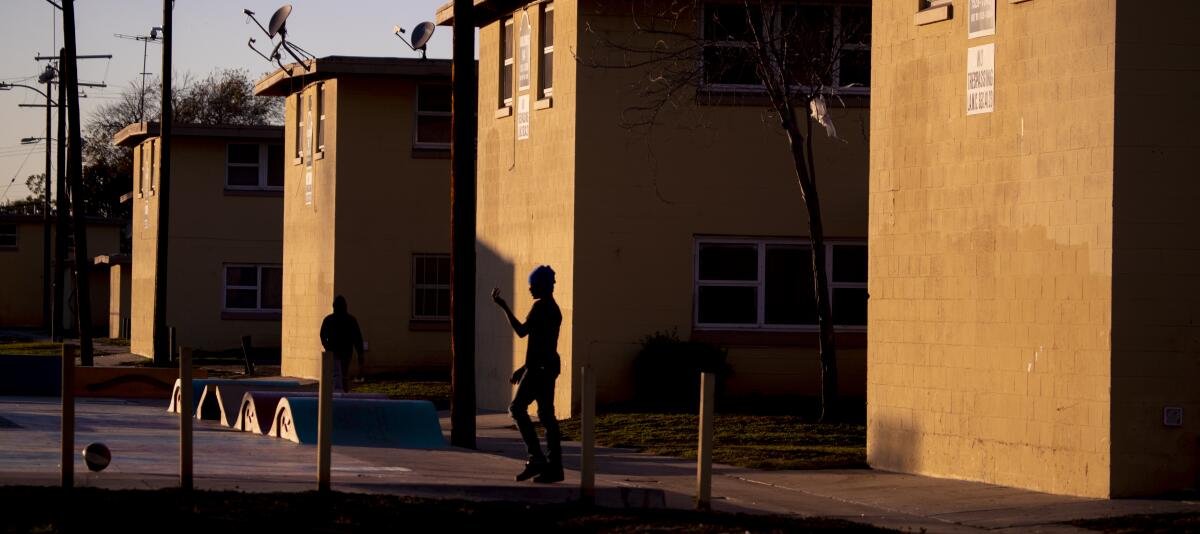
- Share via
Just before 11 p.m. on a recent Friday, ChaSharee Hunter saw several Los Angeles Police Department squad cars rolling into Nickerson Gardens.
She watched as officers jumped from their cruisers and began chasing a teenage boy around a courtyard where Hunter and her friends were hanging out.
But her mild amusement at seeing the youngster outrun the authorities turned to anger when police detained a bystander who they claimed “bumped” into an officer, Hunter said. A crowd soon gathered around the officers, shouting profanities and insults.
Tempers got even hotter when police tried to yank the youth down by his leg from a tall iron picket fence he had climbed to escape, according to Hunter and witnesses’ cellphone videos.
By then, more police swarmed the area.
As the chaotic scene dragged on, Hunter leaned over to record an officer’s name tag with her cellphone. The next thing she knew, an officer grabbed her by the arm and began “repeatedly socking me in my face,” she recalled during an interview with The Times.
Footage of Hunter’s violent arrest soon spread on South L.A. social media, on which critics accused the LAPD of overreacting and making matters worse. Police have said they were defending themselves against a crowd that had turned hostile.
The June 2 episode has threatened the delicate fabric of the Community Safety Partnership program at Nickerson Gardens. Like at its sister sites across the city, the LAPD’s signature community policing initiative has been credited with reducing violent crime and improving relations at the massive housing development in Watts.
But residents and those who work at Nickerson say the more aggressive style of policing of other units sometimes undermines the relationships built there with CSP officers.
“Where is the community policing relationships after 10 [p.m.]?” asked Kevin Hunt, co-founder of Watts Community Core, a nonprofit that provides food and support to needy local families.
The Nickerson native said he found it ironic that law enforcement touts how such outreach efforts have led to reductions in violence at the development. Because when officers from the Southeast Division — and, from time to time, those from the gang unit or elite Metropolitan Division — patrol the area after dark, they still routinely resort to what he describes as the same bullying tactics used when crime was high.
“They’ll go back to old data, but it hasn’t been a drug raid in here since 2005, and so how is it a high drug area when you’re not getting any drugs out of here?” he asked.
LAPD statistics show a general downward crime trend at the 10 CSP sites since the program’s creation in 2011, despite a spike at the height of the COVID-19 pandemic. Homicides at all CSP sites rose to 17 in 2021 from six the year before, but then fell to five in 2022.
Watts had at least 22 homicides in 2021, a more than fivefold increase from 2018. But “Watts is not equal to crime,” one resident says.
Robberies and aggravated assaults also decreased last year, as did the number of people who were struck by gunfire. Property crimes fell across the board, with the exception of grand theft auto, the department numbers show.
CSP is based on the “guardian” mentality of policing instead of the traditional “warrior” approach. Arrests matter less than getting to know residents — and working together to solve an area’s unique problems.
LAPD Deputy Chief Emada Tingirides told The Times that officers are expected to commit to the program for at least five years, with a goal of forming meaningful connections with the community through youth football teams and mentorship programs. They are trained to make arrests as a last resort, although they are still expected to act if confronted with an armed suspect, she said.
For some time now, CSP officers have been working with the Southeast Division’s gang unit to “mitigate large gatherings and crowds inside the housing developments,” which she said can be a magnet for trouble.
Tingirides, who runs the department’s Community Safety Partnership Bureau, said she regularly hears from the area’s Black and Latino residents. They feel besieged in their own homes, she said, complaining about quality-of-life issues that come with such gatherings, including trash, double parking and graffiti.
She disputed that Southeast patrol or gang unit officers were any more heavy-handed in their approach, saying that they, like their counterparts in CSP, aimed “to build relationships and trust and give voice to the victims.” If confronted with an armed suspect, she said, CSP officers would also have sprung into action.
“The videos that are circulating on social media don’t tell the whole story,” Tingirides said. “We did have two officers just cold-cocked and punched in the face unexpectedly. And that is something that we have to hold the community accountable for as well.”
Still, recognizing the heightened tensions from the incident, she and Chief Michel Moore called an emergency meeting with community leaders to discuss a path forward.
She said attendees agreed on several possible solutions, including working with the Housing Authority of the City of Los Angeles to address the presence of nonresidents and turning to community ambassadors, instead of police, to disperse large gatherings before they can get rowdy.
According to LAPD spokeswoman Capt. Kelly Muniz, officers arrested five people after the melee, including the 15-year-old boy who she said led police on a chase and was found in possession of a semiautomatic handgun. Several officers sustained minor injuries, bruises and scratches after being attacked, she said.
The department has also initiated an investigation into the use of force “because of the public dissatisfaction viewed on body worn video” and after receiving a public complaint, the spokeswoman said.
Mayor Karen Bass and other leaders have in recent months talked of expanding CSP. An outside firm has already begun surveying residents at two proposed sites. But at a recent budget hearing, Councilmember Monica Rodriguez told department officials that it was premature to talk about adding sites before the program’s effectiveness could be studied further.
Despite its reported successes, the program has its skeptics outside the department. One recent study questioned whether CSP actually reduces crime or simply displaces it. The program has also been met with resistance from those who have called for diverting some police funding to social services, arguing that the community’s needs could be better filled by trained civilian professionals.
What the recent incident in Nickerson made clear is that, for all the apparent gains made by CSP, decades-old distrust of law enforcement still runs deep in those communities, said Jorja Leap, a gang expert and professor of social work at UCLA.
“I think most significantly this points to the gap that still exists between the standard LAPD patrol officer and the CSP officer,” said Leap, who led a landmark 2019 study of CSP. “There is an underlying fear in Watts in general …that this isn’t going to last, that the old LAPD will sort of rear its head, and things will go back to the brutalities of the past.”
Yet, despite the creation of a stand-alone CSP bureau in 2020 and public proclamations of support by LAPD leadership, longtime civil rights attorney Connie Rice said she questions the department’s level of commitment to the program behind the scenes.
A UCLA study compared outcomes in two Watts housing projects where community policing was practiced with similar areas where it wasn’t.
“It’s difficult to incubate a guardian model of policing inside a paramilitary shock and policing culture,” said Rice, who co-founded the program along with former LAPD Chief Charlie Beck. “It takes leadership to make that transition, and you have to have the right leadership to make that work. We had that with Chief Beck.”
Hunter said she grew up in one of the yellow, low-slung apartment houses the make up Nickerson, but moved to the nearby city of Hawthorne in 2017. She still goes back regularly to her childhood home to visit friends and family, as she did on the night of the incident.
Hunter said she was hanging out in one of the courtyards drinking with relatives, friends and neighbors, celebrating the birthday of her children’s late grandfather. They watched as the teen led officers on a chase through the complex.
The encounter took a turn when police first tried to detain a man, and then several others, who they insisted were interfering with their duties.
Hunter said she was filming an officer’s name tag when she was suddenly grabbed and punched repeatedly. She said she struggled to free herself from his grasp, while trying to block the blows with her free hand. With her back against an LAPD cruiser, Hunter tried to break free and get back to the crowd, some of whom were fighting with officers.
Video courtesy of ChaSharee Hunter.
Hunter said that, after her arrest, she was taken to the Southeast police station, where she was booked on suspicion of resisting arrest and assault on a police officer. Police were slow to offer her medical attention for her injuries, including two black eyes, she said.
She said she was in police custody for nearly nine hours, spending the night in a jail cell until her mother bailed her out in the morning.
“I just feel like they have a set of people working in these projects to build relationships with [community members],” said Hunter, who posted a short video on social media in which she expressed her thanks to family and friends, as well as to the countless well-wishers who reached out after the incident. “And the gang force basically comes over here creating more problems when they do come.”
Even as she tries to process what happened, Hunter said, she is struggling with how to talk to her three children about the need to respect authority figures.
“Because how would that look, me telling you, ‘Oh, respect the police, oh, do your best to stay out of the police way,’ when I tell you, ‘Oh, the police beat up your mom’? That’s contradictory,” said Hunter, a homemaker who previously worked as a medical assistant and armed security guard.
Michelle Catalan, a lifelong Nickerson resident, said she heard secondhand about the incident, which played out on a dusty courtyard near the heart of the development that locals have dubbed the “Mini Field.” What she was told didn’t surprise her.
Some officers have taken the time to build a rapport with the community, getting out of their squad cars and stopping to chat when residents are out barbecuing. But others seem to take pleasure in antagonizing residents by speaking to them disrespectfully, she said.
“Officers are the ones who initiate the argument. And being from Nickerson and being who you are, it’s like you’re not going to allow that,” she said.
That point was driven home for her one night last September when she said police showed up to serve a search warrant on the unit next to hers. When she asked what was going on, one of the officers brushed her off, saying something to the effect of “B—, get out of my face,” Catalan recalled. When she confronted a supervisor at the scene, he told her that he didn’t owe her any explanation, she said.
“During the daytime, while the officers are around, it’s like everything’s nice,” she said. “And during the nighttime, officers will stop you for no reason.”
More to Read
Sign up for Essential California
The most important California stories and recommendations in your inbox every morning.
You may occasionally receive promotional content from the Los Angeles Times.
